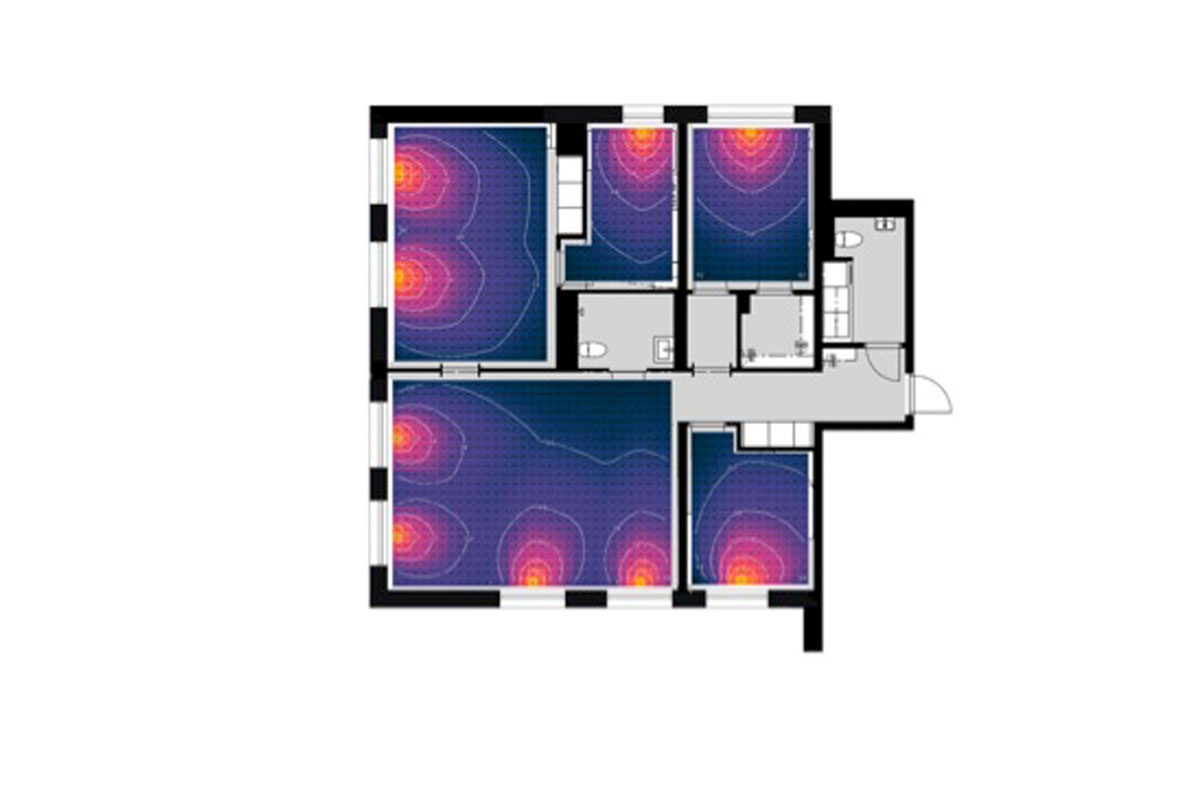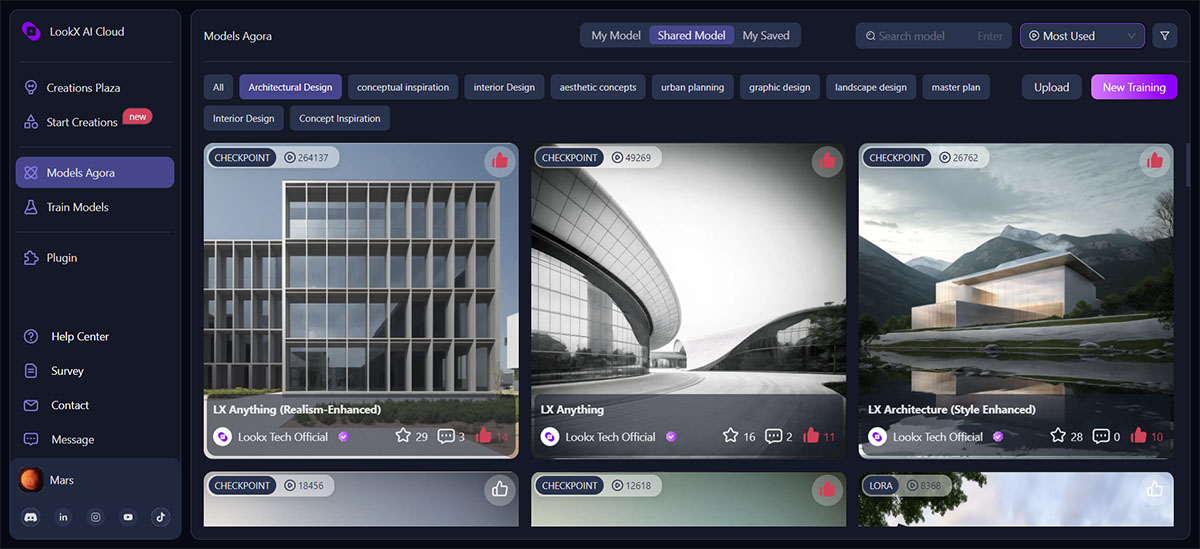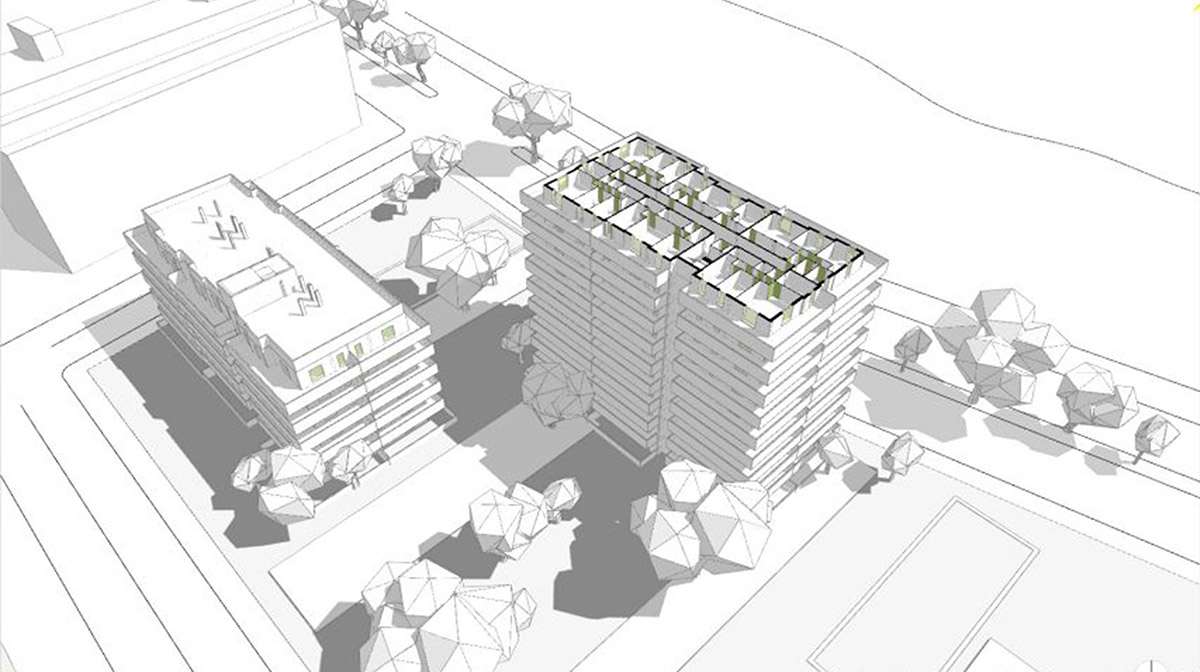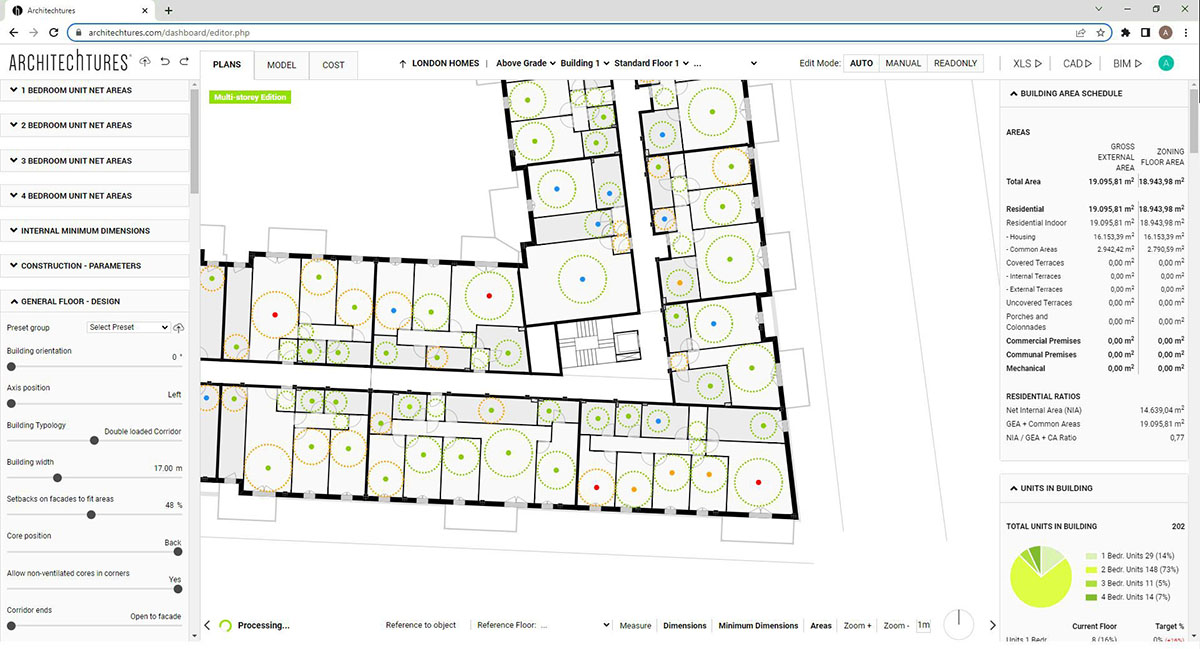Submitted by Berrin Chatzi Chousein
AI can amplify human creativity and capabilities, argue AI experts
United Kingdom Architecture News - Jun 18, 2024 - 10:03 4105 views

Rather than limiting architects and designers with stereotypes, AI can amplify human creativity and capabilities, argue AI experts.
Experts from four AI-powered companies developing Artificial Intelligence (AI) tools and products believe that artificial intelligence will increase creativity and problem-solving ability, rather than imitating certain human behaviors and stereotypes.
In recent years, many technology companies have released AI-driven software that uses deep neural network architecture to transform users' text input into AI-generated images.
While these were primarily limited to software such as Midjourney, DALL-E, and Stable Diffusion, the number of these tools gradually increased and artificial intelligence began to transform architectural production and drawing tools in the industry.
In light of this, we are introducing our brand-new series, Archi-ficial Intelligence, to explore the future of the profession, new methods of production in architecture, and the impacts of AI on design and architecture. Our new series forms the fourth part of the series, titled Archimoments, the WAC Innovative Minds: Communication In Architecture, and the WAC Innovative Minds: Architectural Visualization.
Our fourth series features exclusive interviews with four AI experts from Artificial Intelligence-powered companies; Spacio CEO Franz Forsberg, LookX AI CEO Wanyu He, Architechtures CEO & Co-founder Juan Bordallo, and Hektar co-founder, Tech Lead & Data Scientist, Alexander Radne.
Continue reading for an edited transcript of the four AI experts' interviews conducted in the architecture industry:

Visual from Spacio. Image courtesy of Spacio
"Architects afraid of these kinds of tools should be confident in their domain expertise"
Spacio, CEO Franz Forsberg
Spacio CEO Franz Forsberg believes that professionals in the architectural field who are afraid of AI-based tools should depend on their knowledge of all the other facets of architecture that are not coded or digitalized.
Spacio is a brand-new, state-of-the-art design tool that allows architects, engineers, and property developers to plan, and optimize buildings.
"Spacio is a design tool created on a unique data structure enabling a great level of automation regarding the calculation of essential metrics, parametric and generative design from the city scale to the apartment level, and environmental analysis," said Franz Forsberg, environmental designer and CEO of Spacio.
"Spacio’s vision guides designers from the very early stages to a building permit, ensuring every aspect of the project, regarding architecture and building performance, are complying with the specific regulations."
"Regarding generative design and automation of design proposals, Spacio solely relies on algorithms to suggest alternatives based on the user input settings."
"Regarding performance analysis, for example, the prediction of daylight factors inside rooms or prediction of energy use at the building level, we generate in-house our training data from thousands of validated cases, the so-called ground-truth, that we pair with design parameters to feed our machine-learning models," Forsberg explained.

Mockup of the daylight prediction AI. Image courtesy of Spacio
"Our intention, as architects, with Spacio, is to help designers browse and consider a vast set of design options as early as possible," said Forsberg.
"Spacio is here to help you in your creative process, presenting you with options that could start as a starting point, and giving you all the KPIs needed to make data and facts-informed decisions."
"We cannot prevent architects from designing ugly buildings"
Forsberg responds to the question of whether AI systems can generate a final product in an era where information is so intertwined without depending on specific "stereotypical" patterns: "Stereotypes are sometimes good, especially in the present time where modularity and efficient construction sites with low carbon emissions are valued."
"Spacio will propose some starting points, but it is up to the architect to take the lead and deliver responsible projects."
“We cannot prevent architects from designing ugly buildings," he added.
For now, Spacio is focusing on the Scandinavian, Germanic, and British markets, where the office's architectural knowledge is strong. The company later plans to adapt Spacio to different locations around the world.
He added, "The long-term vision is to grow an international user base, and features related to automated compliance with regulations, so Spacio can learn from every successful project designed around the world, and strengthen its recommendations to users."
Forsberg doesn't believe that AI alone can solve everything. According to him, the human brain and the ability to make judgements are still unique to humans.
"We do not believe AI can or will be able to solve everything. It may consider more and more and produce forever more value, but there is something about the human mind, our specific judgement, that is still untouched by AI," he explained.
"I believe domain expertise will always be necessary and valued in our societies, and I think only the ones with strong expertise should be able to control such tools."
"With great power comes great responsibility. Spacio is not here to replace anyone but to help everyone make better design decisions," he concluded.

Wanyu He, CEO of LookX AI. Image courtesy of Wanyu He
"Strict adherence to architectural logic"
Wanyu He, CEO of LookX AI
Los Angeles-based company LookX AI is an emerging company that focuses on artificial intelligence and architectural design. What distinguishes LookX are two genes: architectural design and digital intelligence.
The company was founded by architects, AI scientists, computer engineers, cross-border designers, and talents from various backgrounds.
"LookX is a cutting-edge AI image generation platform specifically tailored for designers in the architecture and space-related industries," said Wanyu He.
Speaking to the World Architecture Community, she highlighted that LookX expands designers' creative input and ensures that their visions are realized quickly and precisely.
"By harnessing the power of artificial intelligence on the cloud, LookX empowers designers to bring their most imaginative concepts to life and train AI models that cater to their professional design requirements."
"Our platform revolutionizes the design process by expanding designers' creative input and enabling rapid and precise realization of their visions. Through LookX, designers gain access to a wide array of reliable and user-friendly AI tools that seamlessly integrate with the construction industry."
"At LookX, we are guided by a fundamental principle: strict adherence to architectural logic. This principle permeates every aspect of our platform, from the underlying technological architecture to the training data, annotation methods, and features we employ. By considering architectural scenarios and their rationality, we foster innovative design solutions that are rooted in sound architectural principles," she added.
Stating that separate tools such as Rhino and Sketchup were used for different design phases, she emphasized that they developed special training models for each scenario and facilitated the production of architects' models in visualization.
"This tailored approach enables architects to leverage the full potential of our platform, producing outcomes that are both visually stunning and architecturally coherent," said Wanyu He.
"By integrating architectural logic into every facet of our platform, we empower designers to explore new frontiers in their creative journey while maintaining a strong foundation in architectural principles," He explained.

Images from LookX AI. Image courtesy of LookX AI
"Laziness refers to the desire for efficiency and automation"
He claims that AI-based tools express the desire for efficiency and automation that speeds up human progress rather than encouraging a lack of creativity.
Even if AI becomes a powerful tool to drive design, humans will still be the end users, she said.
"Laziness, in this context, refers to the desire for efficiency and automation, which has propelled human progress," said Wanyu He.
"While AI serves as a powerful tool, humans remain the ultimate users. The role of designers may change, but their importance will not diminish. Instead, their focus and the nature of their work will undoubtedly shift. This transformation is akin to the concerns raised when computers and the internet threatened to devalue typists' jobs."
"We firmly believe that the key to success in architecture and all industries lies in embracing and adapting to new technologies. Rather than resisting AI out of fear that it may devalue the work of designers, it is crucial to continuously explore and utilize these tools," He added.

Images from LookX AI. Image courtesy of LookX AI
"AI has the potential to offer fresh perspectives and insights"
Wanyu He believes that AI-based tools will trigger problem-solving and creativity without relying on certain stereotypes. Such tools that go beyond imitating human behavior can offer new perspectives and insights, according to her.
"The emergence of the "transformer" framework is an extraordinary milestone in the history of AI. It signifies a significant leap forward, as it represents the first time computers have been equipped with a structure that closely resembles the complexities of the human brain," He said.
"The advent of chatGPT, a prime example of the transformer framework, has been nothing short of groundbreaking. It has demonstrated that once AI surpasses a certain threshold of trained knowledge, it can exhibit emergent capabilities that go beyond mere replication of past cases."
"By bridging the gap between artificial intelligence and human cognition, these advancements open up new possibilities for collaboration and innovation. AI is no longer confined to mimicking human behaviour but has the potential to offer fresh perspectives and insights."
"Looking ahead, the integration of AI's thinking patterns with human intelligence holds immense potential. By leveraging the strengths of both, we can unlock new frontiers of discovery, problem-solving, and creativity," she added.

Images from LookX AI. Image courtesy of LookX AI
"AI indeed has the potential to replace specific roles"
Speaking on the future impact of AI on the architecture profession, He believes that AI will replace certain roles in the industry. He believes that AI will not only replace architects but will redefine the role and functional content of architects.
"If we confine architects to their current job functions alone, AI can potentially replace those specific roles. However, taking a broader perspective, AI will not simply replace architects but reshape the entire industry, redefining architects' roles and functional content," He said.
"It is important to recognize that the advent of new technologies does not spell the complete elimination of an industry. Instead, these technologies serve to transform industries, offering a more diverse and enriched range of job opportunities. The driving force behind displacement is not the technology itself but rather the individuals who possess an exploratory spirit, a thirst for knowledge, and a willingness to embrace new ideas."
"The emergence of new technologies will not obliterate an industry; rather, it will spark a transformation that brings forth greater diversity and richness in job content."
"Architects, in particular, will continue to play a vital role in shaping the built environment, collaborating with AI to achieve innovative and sustainable design solutions," she continued.
"Architects must ensure that AI is used responsibly and ethically"
While copyrights and the ethical framework surrounding the use of AI are still being debated, He emphasizes that it is important to address ethical considerations.
He advocates that architects must use artificial intelligence within "responsible and ethical" limits, taking into account issues such as data privacy, algorithmic bias, and social freedom.
"By working alongside AI, architects can augment their creative thinking and problem-solving abilities, leading to more dynamic and imaginative designs," He said.
"As AI becomes increasingly integrated into the architecture industry, it is important to address ethical considerations. Architects must ensure that AI is used responsibly and ethically, taking into account issues such as data privacy, algorithmic bias, and the impact on social equity," she concluded.

Juan Bordallo, CEO & Co-founder of Architechtures. Image courtesy of Juan Bordallo
"The traditional design process is based on intuition"
Juan Bordallo, CEO & Co-founder of Architechtures
Architechtures is a building design tool driven by generative AI that can help create the best residential complexes in minutes rather than months. The tool, which is widely used by architects and real estate developers, optimizes the feasibility analysis process with speedy iterations, regulatory confidence, and precise quick insights.
"The goal of this technology is to augment the designers’ capabilities to help them realize their visions far faster and better than ever before," said Juan Bordallo, CEO & co-founder of Architechtures.
"The platform uses GenAI to generate in real-time the geometry that best fits the design objectives and criteria entered by the user for a conceptual mass, providing the building plans and the BIM model, at a schematic design-level, in real-time."
"Comprehensive metrics are instantly provided for each iteration to assess the detailed impact of design decisions, allowing direct interaction with the results in a seamless human-machine collaboration. This technology enables AI-Powered BIM modelling, which augments designers' intuition, accuracy, and efficiency," he explained.
According to Bordallo, the program can autonomously learn to design endless variations of building typologies, starting from examples the system currently uses.
"The technology is based on a proprietary training process called self-generative learning, whereby the system can autonomously learn to design endless building typologies variations starting from provided samples," he added.

Massing study from Architechtures platform. Image courtesy of Architechtures platform
"AI can dramatically amplify human capabilities"
Bordallo states that traditional design processes are based on architects' intuition, personal knowledge, and special experiences. This highlights the fact that adjusting factors that impact a building can be time-consuming and error-prone. However, he believes that GenAI will speed up the decision-making process by increasing human intuition and ability in the design process.
"The traditional design process is based on intuition (decisions are based on the designer’s personal knowledge and particular experience), can lead to human error (human capability in complex situations can lead to sub-optimal solutions), and is highly time-consuming (it takes months to address all the variables that affect a building design)," said Bordallo.
"From this perspective, we believe that generative AI applied to the building design process can bring us many benefits by dramatically amplifying human capabilities: GenAI can augment our intuition (AI fed with millions of designs can recommend better solutions to enhance decision-making), enhance our precision (designs are scientifically optimized concerning quantitative criteria), and make our way more efficient (instant generation reduces design time from months to minutes)."
"Designers working in collaboration with generative AI can easily prototype their ideas, evaluate the impact of their design decisions, and get instant feedback to quickly evolve their design," he added.

Floor plan using Architechtures platform. Image courtesy of Architechtures platform
"Generative AI and Machine Learning transform knowledge into skills"
Bordallo also highlighted that "Generative AI and Machine Learning ultimately allow us to outsource the learning process from our brains to a machine, which is the process of transforming knowledge into skills but this time in a highly scalable way, without the limitation of our biological systems."
"This ultimately allows us to build a pool of common knowledge, thus AI trained with our industry collective experience becomes a common asset ready to help architects come up with the solution that solves their particular problem in their current practice."
Bordallo provides an additional example from one of his platform's projects. He explained that five different architects using Architechtures in the same project revealed five completely different visions. This means that how AI-driven tools can uncover creative design patterns.
"A new AI-driven design process should allow bringing the imagination and creativity on top of the technical knowledge," he said.
"This is what has led us to build an interface that favors the interaction between humans and machines, making the design generation much more efficient but at the same time allowing total control over the design and the designer's input."
"In this way, we have witnessed this in our platform: 5 architects using the platform on the same project, produce 5 completely different results, materializing the 5 different visions that each designer has on how to respond to the objectives and constraints of the project," Bordallo explained.

Floor plan using Architechtures platform. Image courtesy of Architechtures platform
According to Bordallo, it will take a long time for artificial intelligence to fully replace humans. He believes that the machine still lacks human and immeasurable inputs such as emotions, empathy, or consciousness.
"While computers work very accurately and efficiently with the quantitative aspects of a design, which can mean the feasibility of the project, computers are not yet able to deal with aspects such as feelings, empathy, or consciousness, aspects that are key in the final quality and value of an architectural process and what ultimately makes the difference between a great design and an ordinary one," he said.
"We don't yet know how these abilities work in our brains, (maybe that's why we can't quantify them and don't call them quantitative or objective aspects), so for now, and most likely for a long time to come, they are only human capabilities," Bordallo added.

Visual from Parametric platform. Image courtesy of Parametric
"Hektar encourages creativity by expanding the range of design possibilities"
Alexander Radne, co-founder of Parametric and Hektar
Hektar was launched in the spring of 2024 as a sub-product of Parametric, a generative tool to assist steer planning in the right direction by generating and evaluating concepts at an earlier stage. Hektar is an AI-powered generative design tool and a map-based platform with an intuitive web interface that supports 3D exporting among other features.
Architects, engineers, and developers utilize the platform to combine the human creative touch with the intelligence of code to assist build their volume studies throughout the early stages of urban planning.
"Hektar is a generative design tool that simplifies early-stage urban planning by quickly generating multiple design proposals based on input parameters," said Tech Lead and Data Scientist Alexander Radne.
"It helps architects save time, explore more design options, and make data-driven decisions, ultimately enhancing creativity and efficiency."
"Hektar uses AI to analyze input parameters like zoning laws, environmental data, and client requirements. It generates design proposals by optimizing these inputs through algorithms," Radne explained.
"Key features include a user-friendly web interface, a map-based platform, rapid 3D exports, and real-time adjustments, allowing architects to refine designs quickly," he said.
Radne disagrees with arguments that artificial intelligence-driven tools hinder creative thinking, on the contrary, he believes that they enable designers to explore and increase creativity.
"Hektar enhances the design process by providing quick, varied design alternatives, freeing architects to focus on creative and strategic aspects," Radne explained.
"While it streamlines routine tasks, it encourages creativity by expanding the range of design possibilities. Rather than promoting laziness, it empowers designers to explore and innovate more effectively."

Visual from the Hektar platform. Image courtesy of Hektar
"Unique and context-sensitive designs"
Radne also underlines that the algorithms in the design process move away from stereotypes and that they constantly improve Hektar algorithms to make them even more liberal.
"We are constantly improving the Hektar algorithms, analyzing user feedback and design outcomes to refine its algorithms," he said.
"We strive to balance creativity and functional requirements, encouraging unique and context-sensitive designs. We are currently researching different AI models that will allow our users to gain more influence over the designs."
"AI will not replace architects in the future"
According to Radne, AI will not replace the subtle human touch and creativity that are essential in architecture. He emphasizes that in the future, artificial intelligence will enable human-centered design, and development will be based on collaborative work between artificial intelligence and architects.
"AI and machine learning are powerful tools that augment architects' capabilities but cannot replace the nuanced human touch and creativity essential in architecture," Radne explained.
"They handle repetitive and data-intensive tasks, allowing architects to focus on innovative, human-centered design. The future lies in collaboration between AI and architects, not replacement."
"We believe Hektar represents the future of architectural design, combining advanced technology with human creativity. It aims to transform urban planning by making the design process more efficient, sustainable, and inclusive," Radne concluded.
This article has been published as part of the Archi-ficial Intelligence series.
We invite you to join our interview series to discuss the future of artificial intelligence together. If you have an AI-powered tool or service for Architecture and Design, contact us to take part in the series: [email protected]. Selection for the interview at WAC's discretion.
Additionally, if you're a Service and Tool Provider Professional, you can publish your tools/services and list your brand on the World Architecture Community's Professionals page getting exposure to our global audience and architecture & interior design members. WAC's Professional Membership is subjected to an annual fee. You can find out details here.
Top poster image © World Architecture Community.
AI Archi-ficial Intelligence artificial intelligence software design technology
